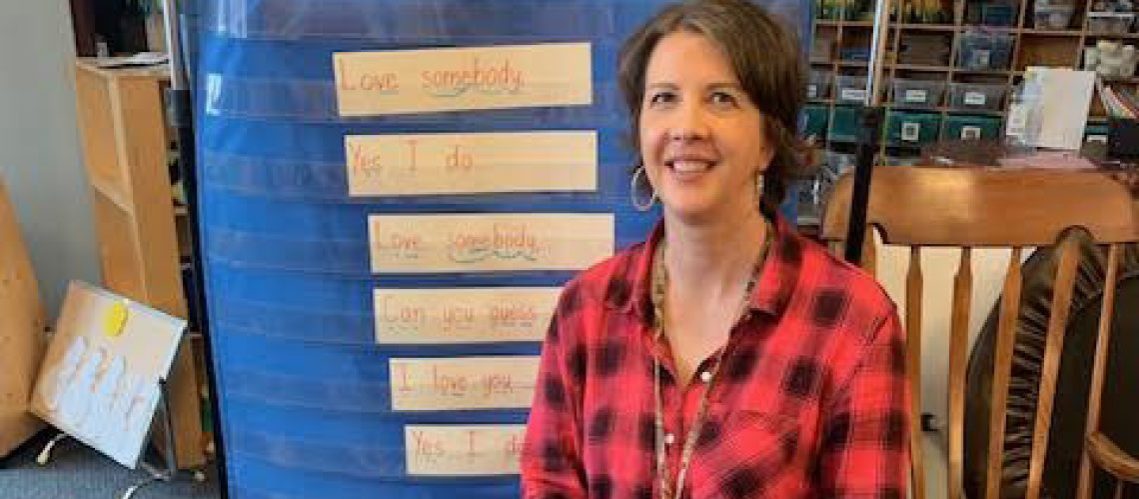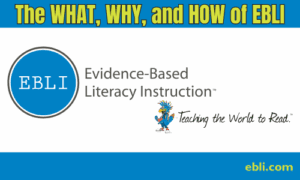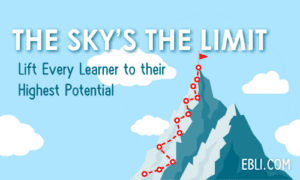The 2019-2020 school year proved to be quite the year for US schools (and schools all over the world). In Michigan, where there were 120,000+ kindergartners across nearly 3,000 schools, it was also the sixth year the state implemented common core standards in full.
Julie VanLier, a Michigan Kindergarten Teacher of nearly 20 years, explains how the stakes have been set higher and higher:
“In kindergarten, with Common Core,” she explains, “they have to be reading.”
HOW EBLI HELPED JULIE TO GET HER STUDENTS READING
It’s a tall order for any teacher, even a veteran like Julie. “I’ve always thought I had been doing a good job,” she shared. “When I first started teaching, reading was taught in first and second grade, but we’ve moved to the point where you have to be a reader in kindergarten and first grade. But teachers get students in second, third, fourth, and fifth grade who don’t know how to read.”
It’s an issue that Michigan’s government has taken note of. “Michigan has a third grade reading law now,” Julie explains. “If kids can’t read by the time they’re in third grade, they can’t pass on.”
At first glance, this idea makes sense, but as many teachers have experienced, the reality is often a different story. Indeed, in 2019, the year the law went into effect, 54.9% of Michigan’s third graders still did not meet the proficiency standards for literacy.
With this stark fact reflected in both her experiences and also in the numbers, Julie found herself reflecting on the new law. She couldn’t help but think, “Kids leave kindergarten reading, so what’s going on?” Wanting to give her kids the best possible education, she knew she had to ask the hard questions.
The Challenge
Throughout the course of her decades-long career, Julie has done her best to get to the root of the problem. “I have a whole stack of books at home that I’ve read over the years. You don’t know what you don’t know, and if you don’t know the science behind literacy, and you have curriculum people who are telling you what to do based on what they were doing 30 years ago, it just becomes a repetitive cycle.”
Julie’s research revealed some shortcomings in the standard teaching methods of her district. “Our curriculum had us doing incidental phonics,” she says, “so we were doing a mismatch of things ‘here and there’ and only introducing a concept if kids seemed to need it. It turns out we were teaching kids to read the wrong way, by wiring the left side of the brain to read. This isn’t where the reading neural pathways are supposed to be.”
Recognizing that there was room for improvement, Julie scoured the web for solutions, in time coming upon Evidence-Based Literacy Instruction (EBLI).
Impressed with what she learned online, Julie reached out to other teachers in the Michigan area who had undergone EBLI training. “Everyone I emailed responded, and they all said, ‘This has really changed my teaching. My kids know their sounds better, they’re reading quicker, they’ve never done better when it comes to tests.’ I’m geeky when it comes to school stuff like that so I said, ‘Ok, I’ve got to go.’”
Training with EBLI
Just before the 2019-2020 school year started, Julie took the advice of her peers and enrolled in EBLI’s online ETSL training, which includes an orientation followed by an annual training subscription. “It was a one-day orientation, as an overview for how EBLI goes, and background on how sounds can be made with one letter, two letters, three letters, or four.”
While attending her orientation day that included guided hands-on application of the concepts, Julie was able to pick up new skills for her students. It would prove to be an intense, but ultimately simple process. “They did it in chunks,” Julie explains. EBLI provided Julie with intensive online teacher training and student lessons to follow in the classroom, parsed out for her to follow.
“I think that’s why it’s so successful, because normally you have a training, and they’re like, ‘Ok, go ahead. Go do it.’ What makes EBLI so powerful is that Nora has taken the research and she’s organized it in the way we can use it in the classroom. And because we can view the videos at any time during the year, we get very helpful professional development whenever we need it.”
To this day, the EBLI team is never far when Julie needs guidance with her new teaching system. “The turnaround time for an email is really quick. They are so quick to respond and they are so helpful. One time, Nora actually emailed me and said ‘How’s it going?’ It’s just so personable; no question is dumb.”
After the Orientation Day
Of course, the orientation was just the beginning of the journey for Julie, who has been given a literacy toolkit through online training, lessons, support materials, and video resources. “That’s what makes it so powerful,” Julie explains. “We can go to a workshop and take notes, or we can watch it and then teach it in real time.”
The video component has been liberating for Julie. “If we were still following our district’s pacing guide, we would still be doing a sound a day,” she says. “It’s just amazing what the kids can do – and there’s no prep other than sitting on the couch and watching a video, so I don’t have tons of papers that I need to cut out and letters that I need to collect. It’s saving me, personally, a ton of time and it’s also saving me a lot of money.”
ETSL training has also proven handy as her experience with EBLI continues. “You can go back to a video,” Julie says, “and you teach it and try it and you think, ‘Ok, I missed something there,’ so you go back to it and you read it again, and you realize what you forgot.”
In addition, with the online lessons at her disposal, Julie never feels lost. “Constantly having the videos helps to show you what to do next. That’s where your bang for the buck is. That’s why the kids are doing so well.”
EBLI in the Classroom
Beyond the individualized approach to training and the wealth of digital resources are the results in the classroom, which have astounded Julie. “Of my 27 students in 2019-2020, 10 of them came in September not being able to write their name,” Julie explains.
By October 2019, with 34 EBLI lessons under their belt, all 27 of Julie’s kindergarten students found themselves able to write their names on their own, with exceptional proficiency, and they were writing them all with correct upper and lowercase letters. “Normally my kids write a hodge-podge of lowercase mixed with capital letters – if they even know how to form the letter! I’ve never had so many kids who knew all their letter sounds,” Julie says. “They’re all writing their name with the first letter capital and the rest lower case, which has never happened. It’s so amazing to me.”
By March 2020, students were ahead of schedule, reading at a level above where they would have been in June with the previous district curriculum.
“For the most part, my kids were all reading. More than half of my kids were reading above grade level; they had exceeded the end of the year expectation for reading levels – three months before the end of the school year.”
For Julie, the experience has been nothing short of revelatory. “EBLI is the missing link. EBLI is the bridge between the research and what actually happens. My students are learning according to the way research says that the brain learns to read.”
It has proven not only effective as a literacy program, but efficient as a classroom tool.
“I don’t need to waste time teaching word families,” Julie offers as an example, “because that’s not a consistent way of learning, and my kids struggle to read when they get into the higher grades. If they’re just memorizing words, kids get into trouble when they get into harder words and they don’t have those words already memorized.”
It is with this in mind that EBLI goes beyond rote tactics and actually imparts the literacy skills kids need, not only to meet district standards, but also to allow students to excel.
“There’s none of that memorizing in EBLI,” Julie explains. “It’s all reading what’s on the page. There are no gimmicks involved – they’re writing the words, and then they’re reading the words. They don’t need the fluff that the reading “gurus” are pushing.”
Reading and Writing to Build Confidence in Students
With reading skills so successfully imparted on her students, Julie can now cover her entire curriculum and ensure her kids are getting the education they deserve.
“It’s freed up a lot of my time during the day,” she says. “I now have more time to teach science; I have been able to make my math time longer.”
It has inspired an exceptional confidence in her students, too. “They don’t have a fear of failure. Kids in the past that would not have raised their hands to read are reading.”
The experience adds up to a sense of accomplishment— not just for the kids, but for Julie as well. “It makes me feel really proud,” she remarks. “I get goosebumps reading with these kids. They aren’t using any ‘strategies’ – they aren’t looking at the pictures; they aren’t skipping words; they aren’t looking for chunks. If they don’t know a word, they decode it sound by sound. They’re reading!”
Julie remarks upon her children’s new-found skills with a smile. “All the kids see themselves as readers. This year, I never had kids who said it was too hard and I never had kids who said they couldn’t do it.”
This capacity for learning is proving revolutionary for Julie. “I think as a society,” she notes, “we are okay with kids failing – ‘We see where our kids are at the end of the year, and we say to ourselves they can’t all read; that’s how it goes.’”
EBLI directly challenges this type of thinking. “You’re never sending kids off by themselves so they can fail; with EBLI, you’re always right there to help them,” she notes.
What questions do you have for Julie? Let us know in the comments below!





